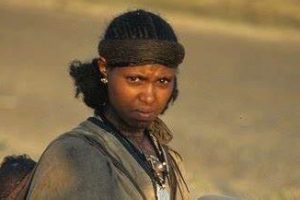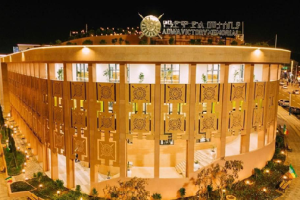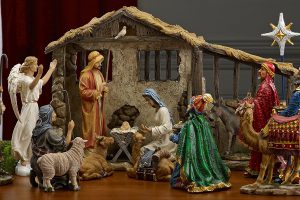
COMPILED BY YOHANES JEMANEH
Born during the Italian occupation in Hararghe to his father Gessesse Qolech and his mother Belletech Yayehyirad, Tesfaye Gessesse was eight months old when his mother died. A year later, he lost his father, Gessese Qolech who was the son of Fitawrari Qolech who served as Ras Mekonnen’s army commander. Tesfaye was brought to Addis Ababa at the tender age of eight at the request of his aunt who wanted him to go to school.
In Addis Ababa, the young Tesfaye started learning in Teferi Mekonnen School. He was a scout, and as such he went camping often, and around the campfire, he would sing and act in skits. At Teferi Mekonnen, he met and became friends with Sebhat Gebre Egziabher, who later became a renowned author and his lifetime friend.
After completing his secondary education, Tesfaye enrolled at the University of Addis Ababa’s Law Faculty where he graduated in 1958. While there, upon watching him play at a drama staged by another prominent playwright, Kebede Michael, Emperor Haile Selassie advised the young Tesfaye to study theatre and arranged for his scholarship at Northwestern University’s theater school, in Evanston, Illinois, USA. Returning in 1961, he worked as a director at the Haile Selassie I Theatre in Addis Ababa. He was the play director there from 1961 to 1963.
He then moved to Haile Selassie I University and helped to establish the Creative Arts Centre under the initiative of the American national Philip Caplan who was working on a Fulbright scholarship at the Addis Ababa University. The two reportedly met in 1962 to co-direct a play and they hit on the idea of starting the drama section at the young Haile Selassie I University.
Tesfaye and Caplan had directed the premiere of plays by the then playwrights including Tsegaye Gebre Medhin and Mengistu Lemma. Solomon Deressa, Haile Gerima, Abate Mekuria, Wogayehu Negatu, Debebe Eshetu, Asfaw Damte, Berhane Meskel Reda were among the active visitors to the center.
Tesfaye was the center’s director for four years. In 1974-1984 he was the director of the Ethiopian National Theatre. After his studies of theater, Tesfaye co-founded the Creative Arts Center and became the General Director of Hager Fikir Theater in 1974. In 1975, he had a well-received play, staged under the title of Tahadisso (Renaissance).
“Following on from Iqaw and Tehaddiso Tesfaye Gessesse continued, in two further plays, his examinations of how fear and mystification can be used as instruments of control,” Jane Plastow, wrote in her book, A History of East African Theatre, Volume 1 (2020).
He is regarded as one of the most important exponents of Ethiopian modern theater. During a career that spanned 40 years, he has been an actor, director, writer and managing director. He wrote and directed several plays which have a great relevance in the modern history of Ethiopian Culture.
One of his one-act plays was produced by the department, but the program notes were read aloud from the stage, prior to the performance, so that their “revolutionary” content would not be reported to the monarchist government which was paying his tuition.
Tesfaye revolutionized the theater in Ethiopia with his plays, acting, directing and teaching. Jane Plastow, Professor of African Theatre at the University of Leeds, UK, described him as one of the three men who would lead a radical change in the form and content of the Ethiopian national drama in the early 1960s, along with Tsegaye Gebre-Medhin, and Mengistu Lemma.
The polished intellectual had written and successfully produced several plays. Among his plays were Father and Sons, the absurdist Iqaw (The thing), Tehaddiso (Renaissance), Yeshi, Cherchez Les femmes, and Ferdun Lenaninte (The judgment is for you).
Tesfaye had directed and starred in multiple plays, including in Tsegaye Gebremedhin’s adaptations of Shakespeare’s Hamlet. He translated a brief sketch of the lives of the Sufi mystic Omar Khayyam and his Rubaiyat.
His short story “Ayee my Luck”, which was translated from the Amharic by Yonas Admassu, attained international recognition through its publication in African Arts in 1971. It gives a trenchant account of an Addis prostitute and her hypocritical customer. Another story, “The Black Cat” (1988) was published in Yekatit magazine.
Speaking about him, many stated that Tesfaye was a straightforward person who love art and people. Artist Debebe Eshetu describes Tesfaye as an art director, actor, poet and teacher who perceived art beyond stage performance.
He was also my older friend. He lived a life made up of art. He had enjoyed the test of loving and to be loved by others. Sometimes, he was stubborn for his belief. And he was able to convince others about his position, he said in a tribute paid to Tesfaye before his funeral.
Now, Tesfaye left us for the inevitable journey (death). Yearning for his brotherliness, friendliness, unlimited artistic gifts and teachings will hurts us most. He lived life based on his preference than going with the flow. He was faultless artist and teacher. Both his hands and residences were always open for others. He transfer heat both when he hug and offer something to others, as to Debebe.
He breathes through generations to produce art pieces that shines beyond dusk and margin. “I will not mourn to him since he has the key of art that gleams over his cemetery.” He was a hub of art and love. He was adorable, tolerant and hard worker.
For his art life and testimony of friendship, I have no bitter mourning but honorable farewell. As his former friend Laureate Tsegye Gebremedhin once wrote, “we should farewell him with the culture of Gamo people who sendoff their hero
singing, clapping and dancing.” Debebe called on stakeholders to join the effort to rediscover Tesfaye’s works and ambition so as to hand over his legacy to the next generation.
According to artist Getinet Enyew, Tesfaye was an all-rounded person having the knowhow of various artistic skills. And he was also defiant to any idea that he doesn’t believe. Loosing such person will hurt us utmost.
“Tesfaye is my mentor,” said artist Alemayehu Tadesse. “He was the one who enabled me to join theatre without fear but with due respect. He leaves in my heart, forever! Actually, we all born to die. It is inevitable and we won’t escape from it since it happens one day in the future.
But one thing we all should note is that we should do something memorable to for our name to persists after we are committed to the grave,” he noted. Tesfaye will live with us together through his artistic pieces and the generation he molded.
Tesfaye was married to Meretush Akalu and they have two children together. Besides his children in bloodline, Tesfaye nurtured many youths in the art industry. He also produced many artistic pieces that cite his name lastingly.
The Ethiopian Herald December 29/2020





